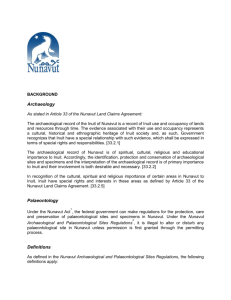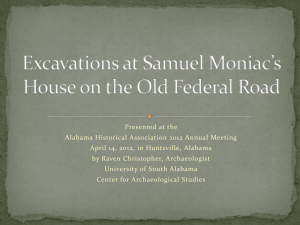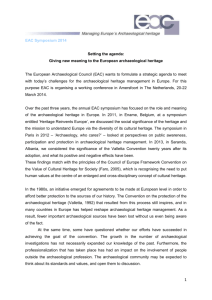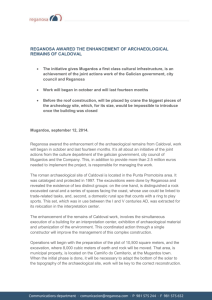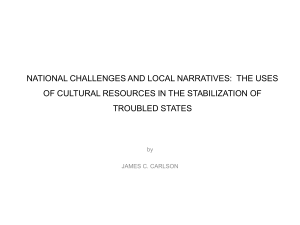110630-11EN035-CLEY T&C-IT6E
advertisement
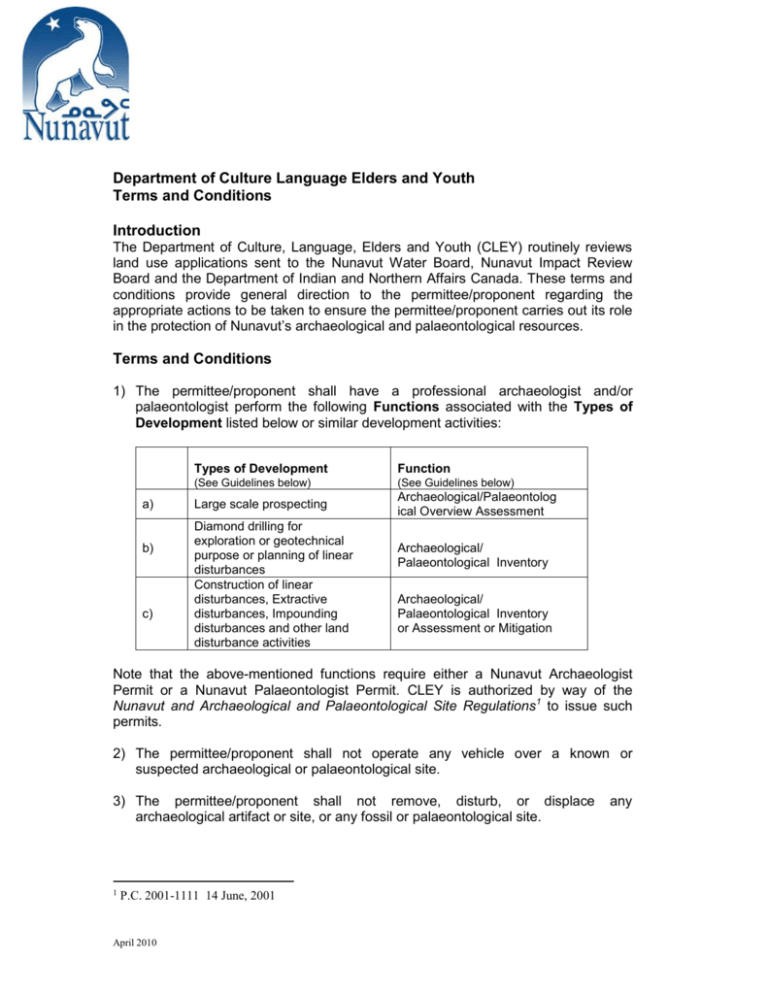
Department of Culture Language Elders and Youth Terms and Conditions Introduction The Department of Culture, Language, Elders and Youth (CLEY) routinely reviews land use applications sent to the Nunavut Water Board, Nunavut Impact Review Board and the Department of Indian and Northern Affairs Canada. These terms and conditions provide general direction to the permittee/proponent regarding the appropriate actions to be taken to ensure the permittee/proponent carries out its role in the protection of Nunavut’s archaeological and palaeontological resources. Terms and Conditions 1) The permittee/proponent shall have a professional archaeologist and/or palaeontologist perform the following Functions associated with the Types of Development listed below or similar development activities: a) b) c) Types of Development Function (See Guidelines below) (See Guidelines below) Large scale prospecting Archaeological/Palaeontolog ical Overview Assessment Diamond drilling for exploration or geotechnical purpose or planning of linear disturbances Construction of linear disturbances, Extractive disturbances, Impounding disturbances and other land disturbance activities Archaeological/ Palaeontological Inventory Archaeological/ Palaeontological Inventory or Assessment or Mitigation Note that the above-mentioned functions require either a Nunavut Archaeologist Permit or a Nunavut Palaeontologist Permit. CLEY is authorized by way of the Nunavut and Archaeological and Palaeontological Site Regulations1 to issue such permits. 2) The permittee/proponent shall not operate any vehicle over a known or suspected archaeological or palaeontological site. 3) The permittee/proponent shall not remove, disturb, or displace archaeological artifact or site, or any fossil or palaeontological site. 1 P.C. 2001-1111 14 June, 2001 April 2010 any 4) The permittee/proponent shall immediately contact CLEY at (867) 934-2046 or (867) 975-5500 should an archaeological site or specimen, or a palaeontological site or fossil, be encountered or disturbed by any land use activity. 5) The permittee/proponent shall immediately cease any activity that disturbs an archaeological or palaeontological site encountered during the course of a land use operation until permitted to proceed with the authorization of CLEY. 6) The permittee/proponent shall follow the direction of CLEY in restoring disturbed archaeological or palaeontological sites to an acceptable condition. If these conditions are attached to either a Class A or B Permit under the Territorial Lands Act INAC’s directions will also be followed. 7) The permittee/proponent shall provide all information requested by CLEY concerning all archaeological sites or artifacts and all palaeontological sites and fossils encountered in the course of any land use activity. 8) The permittee/proponent shall make best efforts to ensure that all persons working under its authority are aware of these conditions concerning archaeological sites and artifacts and palaeontological sites and fossils. 9) If a list of recorded archaeological and/or palaeontological sites is provided to the permittee/proponent by CLEY as part of the review of the land use application the permittee/proponent shall avoid the archaeological and/or palaeontological sites listed. 10) Should a list of recorded sites be provided to the permittee/proponent, the information is provided solely for the purpose of the proponent’s land use activities as described in the land use application, and must otherwise be treated confidentially by the proponent. LEGAL FRAMEWORK As stated in Article 33 of the Nunavut Land Claims Agreement: Where an application is made for a land use permit in the Nunavut Settlement Area, and there are reasonable grounds to believe that there could be sites of archaeological importance on the lands affected, no land use permit shall be issued without written consent of the Designated Agency. Such consent shall not be unreasonably withheld. [33.5.12] Each land use permit referred to in Section 33.5.12 shall specify the plans and methods of archeological site protection and restoration to be followed by the permit holder, and any other conditions the Designated Agency may deem fit. [ 33.5.13] Palaeontology and Archaeology Under the Nunavut Act2, the federal government can make regulations for the protection, care and preservation of palaeontological and archaeological sites and specimens in Nunavut. Under the Nunavut Archaeological and Palaeontological Sites Regulations3, it is illegal to alter or disturb any palaeontological or archaeological site in Nunavut unless permission is first granted through the permitting process. Definitions As defined in the Nunavut Archaeological and Palaeontological Sites Regulations, the following definitions apply: “archaeological site” means a place where an archaeological artifact is found. “archaeological artifact” means any tangible evidence of human activity that is more than 50 years old and in respect of which an unbroken chain of possession or regular pattern of usage cannot be demonstrated, and includes a Denesuline archaeological specimen referred to in section 40.4.9 of the Nunavut Land Claims Agreement. “palaeontological site” means a site where a fossil is found. “fossil” includes: Fossil means the hardened or preserved remains or impression of previously living organisms or vegetation and includes: (a) natural casts; (b) preserved tracks, coprolites and plant remains; and (c) the preserved shells and exoskeletons of invertebrates and the preserved eggs, teeth and bones of vertebrates 2 3 s. 51(1) P.C. 2001-1111 14 June, 2001 Guidelines for Developers for the Protection of Archaeological Resources in the Nunavut Territory (Partial document, complete document at http://www.gov.nu.ca/cley/english/arch.html) Introduction The following guidelines have been formulated to ensure that the impacts of proposed developments upon heritage resources are assessed and mitigated before ground surface altering activities occur. Heritage resources are defined as, but not limited to, archaeological and historical sites, burial grounds, palaeontological sites, historic buildings and cairns Effective collaboration between the developer, the Department of Culture, Language, Elders and Youth (CLEY), and the contract archaeologist(s) will ensure proper preservation of heritage resources in the Nunavut Territory. The roles of each are briefly described. CLEY is the Nunavut Government agency which oversees the protection and management of heritage resources in Nunavut, in partnership with land claim authorities, regulatory agencies, and the federal government. Its role in mitigating impacts of developments on heritage resources is as follows: to identify the need for an impact assessment and make recommendations to the appropriate regulatory agency; set the terms of reference for the study depending upon the scope of the development; suggest the names of qualified individuals prepared to undertake the study to the developer; issue an archaeologist or palaeontologist permit authorizing field work; assess the completeness of the study and its recommendations; and ensure that the developer complies with the recommendations. The primary regulatory agencies that CLEY provides information and assistance to are the Nunavut Impact Review Board, for development activities proposed for Inuit Owned Lands (as defined in Section 1.1.1 of the Nunavut Land Claims Agreement), and the Department of Indian and Northern Affairs, for development activities proposed for federal Crown Lands. A developer is the initiator of a land use activity. It is the obligation of the developer to ensure that a qualified archaeologist or palaeontologist is hired to perform the required study and that provisions of the contract with the archaeologist or palaeontologist allow permit requirements to be met; i.e. fieldwork, collections management, artifact and specimen conservation, and report preparation. On the recommendation of the contract archaeologist or palaeontologist in the field and the Government of Nunavut, the developer shall implement avoidance or mitigative measures to protect heritage resources or to salvage the information they contain through excavation, analysis, and report writing. The developer assumes all costs associated with the study in its entirety. Through his or her active participation and supervision of the study, the contract archaeologist or palaeontologist is accountable for the quality of work undertaken and the quality of the report produced. Facilities to conduct fieldwork, analysis, and report preparation should be available to this individual through institutional, agency, or company affiliations. Responsibility for the curation of objects recovered during field work while under study and for documents generated in the course of the study as well as remittance of artifacts, specimens and documents to the repository specified on the permit accrue to the contract archaeologist or palaeontologist. This individual is also bound by the legal requirements of the Nunavut Archaeological and Palaeontological Sites Regulations. Types of Development In general, those developments that cause concern for the safety of heritage resources will include one or more of the following kinds of surface disturbances. These categories, in combination, are comprehensive of the major kinds of developments commonly proposed in Nunavut. For any single development proposal, several kinds of these disturbances may be involved •Linear disturbances: including the construction of highways, roads, winter roads, transmission lines, and pipelines; •Extractive disturbances: including mining, gravel removal, quarrying, and land filling; •Impoundment disturbances: including dams, reservoirs, and tailings ponds; •Intensive land use disturbances: including industrial, residential, commercial, recreational, and land reclamation work, and use of heritage resources as tourist developments. •Mineral, oil and gas exploration: establishment of camps, temporary airstrips, access routes, well sites, or quarries all have potential for impacting heritage resources. Types of Studies Undertaken to Preserve Heritage Resources Overview: An overview study of heritage resources should be conducted at the same time as the development project is being designed or its feasibility addressed. They usually lack specificity with regard to the exact location(s) and form(s) of impact and involve limited, if any, field surveys. Their main aim is to accumulate, evaluate, and synthesize the existing knowledge of the heritage of the known area of impact. The overview study provides managers with baseline data from which recommendations for future research and forecasts of potential impacts can be made. A Class I Permit is required for this type of study if field surveys are undertaken. Reconnaissance: This is done to provide a judgmental appraisal of a region sufficient to provide the developer, the consultant, and government managers with recommendations for further development planning. This study may be implemented as a preliminary step to inventory and assessment investigations except in cases where a reconnaissance may indicate a very low or negligible heritage resource potential. Alternately, in the case of small-scale or linear developments, an inventory study may be recommended and obviate the need for a reconnaissance. The main goal of a reconnaissance study is to provide baseline data for the verification of the presence of potential heritage resources, the determination of impacts to these resources, the generation of terms of reference for further studies and, if required, the advancement of preliminary mitigative and compensatory plans. The results of reconnaissance studies are primarily useful for the selection of alternatives and secondarily as a means of identifying impacts that must be mitigated after the final siting and design of the development project. Depending on the scope of the study, a Class 1 or Class 2 Permit is required for this type of investigation. Inventory: A resource inventory is generally conducted at that stage in a project's development at which the geographical area(s) likely to sustain direct, indirect, and perceived impacts can be well defined. This requires systematic and intensive fieldwork to ascertain the effects of all possible and alternate construction components on heritage resources. All heritage sites must be recorded on Government of Nunavut Site Survey forms. Sufficient information must be amassed from field, library and archival components of the study to generate a predictive model of the heritage resource base that will: •allow the identification of research and conservation opportunities; •enable the developer to make planning decisions and recognize their likely effects on the known or predicted resources; and • make the developer aware of the expenditures, which may be required for subsequent studies and mitigation. A Class 1 or 2 permit is required Assessment: At this stage, sufficient information concerning the numbers and locations of heritage resources will be available, as well as data to predict the forms and magnitude of impacts. Assessments provide information on the size, volume, complexity and content of a heritage resource, which is used to rank the values of different sites or site types given current archaeological knowledge. As this information will shape subsequent mitigation program(s), great care is necessary during this phase. Mitigation: This refers to the amelioration of adverse impacts to heritage resources and involves the avoidance of impact through the redesign or relocation of a development or its components; the protection of the resource by constructing physical facilities; or, the scientific investigation and recovery of information from the resource by excavation or other method. The type(s) of appropriate mitigative measures are dictated by their viability in the context of the development project. Mitigation strategies must be developed in consultation with, and approved by, the Department of Culture, Language, Elders and Youth. It is important to note that mitigation activities should be initiated as far in advance of the construction of the development as possible. Surveillance and monitoring: These may be required as part of the mitigation program. Surveillance may be conducted during the construction phase of a project to ensure that the developer has complied with the recommendations. Monitoring involves identification and inspection of residual and long-term impacts of a development (i.e. shoreline stability of a reservoir); or the use of impacts to disclose the presence of heritage resources, for example, the uncovering of buried sites during the construction of a pipeline.
